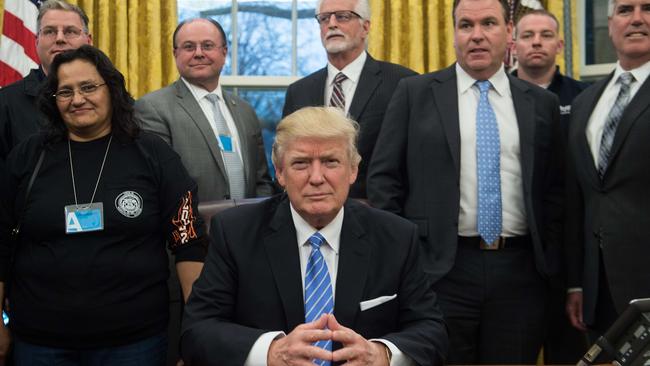How the stockmarket’s Trump Trade got ahead of itself
Markets seem to have capitalised on “America First” policies long before their full detail is available.

In the wake of Donald Trump’s against-the-odds success, US stock markets soared, the US dollar climbed, 10-year Treasuries spiked and gold fell.
As the erratic reality and uncertainty of the post-election period has emerged, with conflicting messages about policy between Trump and his advisers, the dark and aggressive language of the inauguration, the weird and angry focus on the crowd numbers for the inauguration and — as Trump signed the order formally withdrawing the US from the Trans Pacific Partnership — the reality of US protectionism, the markets have fallen back.
The Trump trade was ignited by the market’s enthusiasm for Trump’s plans for big tax cuts infrastructure investment and wholesale deregulation.
In the post-election period that led to a 9 per cent increase in the S&P 500 index, an appreciation of more than 14 per cent of the US dollar against the yen and of more than 7 per cent against the euro. Gold, the reflex safe haven, fell about 13 per cent while 10-year Treasuries hit 2.6 per cent.
Those trades peaked just before Christmas. While still well ahead of their pre-election levels (the S&P is still more than 8 per cent higher and the dollar is still 9.4 per cent higher against the yen and 3.5 per cent against the euro) the fizz has gone out of the trades.
The markets are, it should be noted, still at elevated levels. The S&P is near record levels and, despite falling back this month, is still capitalised at more than 20 times historical earnings and the 10-year bond yield is still a percentage point above its pre-election level.
That says that a lot of optimism about the Trump administration is still priced into the markets.
It does appear, however, that the lack of detail about the policies and how and when they might be implemented, some contradictory statements between Trump and his appointees, inconsistency between what Trump has said about his policies and what the senior Congressional Republicans have said, and a realisation that implementing the policies is likely to be a fairly drawn-out process is affecting investor sentiment.
There’s also the trade issue, with Trump telling US business leaders yesterday that he was serious about punishing companies that invested in offshore production.
‘’If you go to another country and you decide that you are going to close a US factory … we are going to be imposing a very major border tax,’’ he is reported to have said.
The implications of US protectionism for global trade and economic growth, the possibility it might ignite trade wars, the disparate impacts it might have on particular US companies and the potential impact on US inflation rates all make for what is a quite vague policy, so far defined by presidential tweets against auto manufacturers and an air conditioning company.
Similarly, Trump told the business executives that he was going to cut taxes “massively” for companies and middle-class Americans and cut regulations by at least 75 per cent. While those sorts of statements provide broad directions, they lack any specifics and are impossible to price into stocks and markets.
There’s also uncertainty about third-party responses to Trump’s policy agenda if it were implemented. The Federal Reserve Board would inevitably counter the inflationary impacts of stimulus to an economy performing relatively strongly, with higher rates.
US protectionism would have uncertain and uneven impacts on US companies dependent on global supply chains and would provoke responses from America’s trading partners and competitors. Slow world economic growth would also have an impact on US growth.
It’s not predestined that the Trump agenda will be unsuccessful or that, once the administration has had the opportunity to consider the detail of its policies and their impacts more closely, that it will have the net negative effects on the rest of the world that some anticipate.
US protectionism is a negative for the outlook for world growth but a stronger US domestic economy could, depending on how the Trump policies were implemented, be an offsetting positive.
Markets, in their initial enthusiasm for Trump and his pro-growth “America First” policies, have probably got ahead of themselves, however, capitalising the promises before their detail was available and long before their possible implementation.
Because of the length of the post-crisis period and the unconventional policies central banks, including the Fed, adopted and maintained in response to it, investors have been forced to expose themselves to increased risk for decreased returns.
While the Fed has made a modest start towards normalising US rates (and suggested it might go harder and faster if US inflation starts to pick up) there’s not a lot of risk priced into markets and the Trump Trade has made them even more vulnerable to shocks and disappointments by inflating markets further.
It might be that, once Trump and his administration settle into office, they adopt a more conventionally presidential approach than that which has been displayed in the post-election period and the past few days after the inauguration.
If they were, however, to maintain the same aggressive and erratic shoot-from-the-lip approach adopted so far, the markets are in for a quite turbulent and messy period.
The nature of the policy agenda inherently generates winners and losers as well as layers of uncertainty, risk and volatility. The nature of the fledgling administration thus far could exacerbate all those outcomes and influences.
It’s curious that markets haven’t been more volatile in the early weeks of this year. It may, however, be the calm before the storm/s.





Investors haven’t quite lost faith in the “Trump Trade,” but they do appear to have lost some of their conviction as the post-election euphoria in US markets has morphed into uneasiness.